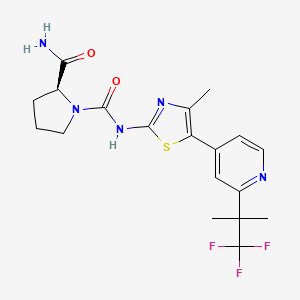



1. Byl719
2. Nvp-byl719
3. Piqray
1. 1217486-61-7
2. Byl-719
3. Byl719
4. Piqray
5. Nvp-byl719
6. Vijoice
7. Alpelisib (byl719)
8. (s)-n1-(4-methyl-5-(2-(1,1,1-trifluoro-2-methylpropan-2-yl)pyridin-4-yl)thiazol-2-yl)pyrrolidine-1,2-dicarboxamide
9. Byl 719
10. Chembl2396661
11. 08w5n2c97q
12. (2s)-n1-[4-methyl-5-[2-(2,2,2-trifluoro-1,1-dimethylethyl)-4-pyridinyl]-2-thiazolyl]-1,2-pyrrolidinedicarboxamide
13. (2s)-1-n-[4-methyl-5-[2-(1,1,1-trifluoro-2-methylpropan-2-yl)pyridin-4-yl]-1,3-thiazol-2-yl]pyrrolidine-1,2-dicarboxamide
14. (s)-pyrrolidine-1,2-dicarboxylic Acid 2-amide 1-(4-methyl-5-(2-(2,2,2-trifluoro-1,1-dimethylethyl)-pyridin-4-yl)thiazol-2-yl)amide
15. 1,2-pyrrolidinedicarboxamide, N1-(4-methyl-5-(2-(2,2,2-trifluoro-1,1-dimethylethyl)-4-pyridinyl)-2-thiazolyl)-, (2s)-
16. 1,2-pyrrolidinedicarboxamide, N1-[4-methyl-5-[2-(2,2,2-trifluoro-1,1-dimethylethyl)-4-pyridinyl]-2-thiazolyl]-, (2s)-
17. Alpelisib [inn]
18. (2s)-n~1~-{4-methyl-5-[2-(1,1,1-trifluoro-2-methylpropan-2-yl)pyridin-4-yl]-1,3-thiazol-2-yl}pyrrolidine-1,2-dicarboxamide
19. (s)-n1-(4-methyl-5-(2-(1,1,1-trifluoro-2-methylpropan-2-yl)pyridin-4-yl)thiazol-2-yl)pyrrolidine-1,2-dicarboxamide.
20. Unii-08w5n2c97q
21. 4jps
22. 1lt
23. Alpelisib [usan]
24. Piqray (tn)
25. Alpelisib [jan]
26. Alpelisib [mi]
27. Alpelisib [usan:inn]
28. Alpelisib [who-dd]
29. Alpelisib (jan/usan/inn)
30. Gtpl7955
31. Schembl1911869
32. Alpelisib [orange Book]
33. Chebi:93752
34. Dtxsid70153355
35. Ex-a405
36. Byl 719; Byl719
37. Bdbm50436459
38. Mfcd22417085
39. Nsc765974
40. Nsc800065
41. S2814
42. Zinc68198368
43. Akos022186315
44. Ccg-269139
45. Cs-0663
46. Db12015
47. Nsc-765974
48. Nsc-800065
49. Ncgc00346717-03
50. Ncgc00346717-06
51. (2s)-n1-[4-methyl-5-[2-(2,2,2-trifluoro-1,1-dimethylethyl)-4-pyridinyl]-2-thiazolyl]-1,2-pyrrolidine
52. 1217486-47-9
53. As-16349
54. Hy-15244
55. Sw220128-1
56. Cas:1217486-61-7;byl-719
57. D11011
58. A855666
59. J-004627
60. Q27074391
61. (2s)-n1-(4-methyl-5-(1-(1,1,1-trifluoro-2-methylpropan-2-yl)pyridin-4-yl)-1,3-thiazol-2-yl)pyrrolidine-1,2-dicarboxamide
62. (2s)-n1-[4-methyl-5-[2-(2,2,2-trifluoro-1,1-dimethylethyl)-4-pyridinyl]-2-thiazolyl]-1,2-pyrrolidinedicarboxamide;alpelisib
| Molecular Weight | 441.5 g/mol |
|---|---|
| Molecular Formula | C19H22F3N5O2S |
| XLogP3 | 3.2 |
| Hydrogen Bond Donor Count | 2 |
| Hydrogen Bond Acceptor Count | 8 |
| Rotatable Bond Count | 4 |
| Exact Mass | 441.14463062 g/mol |
| Monoisotopic Mass | 441.14463062 g/mol |
| Topological Polar Surface Area | 129 Ų |
| Heavy Atom Count | 30 |
| Formal Charge | 0 |
| Complexity | 663 |
| Isotope Atom Count | 0 |
| Defined Atom Stereocenter Count | 1 |
| Undefined Atom Stereocenter Count | 0 |
| Defined Bond Stereocenter Count | 0 |
| Undefined Bond Stereocenter Count | 0 |
| Covalently Bonded Unit Count | 1 |
Alpelisib is indicated in combination with fulvestrant to treat postmenopausal women, and men, with advanced or metastatic breast cancer. This cancer must be hormone receptor (HR)-positive, human epidermal growth factor receptor 2 (HER2)-negative, and PIK3CA mutated. The cancer must be detected by an FDA-approved test following progression on or after an endocrine-based regimen.
FDA Label
Treatment of breast cancer
Piqray is indicated in combination with fulvestrant for the treatment of postmenopausal women, and men, with hormone receptor (HR)-positive, human epidermal growth factor receptor 2 (HER2)-negative, locally advanced or metastatic breast cancer with a PIK3CA mutation after disease progression following endocrine therapy as monotherapy (see section 5. 1).
Treatment of PIK3CA related overgrowth spectrum
Treatment of Fallopian tube carcinoma (excluding rhabdomyosarcoma and germ cell tumours), Treatment of ovarian carcinoma (excluding rhabdomyosarcoma and germ cell tumours), Treatment of peritoneal carcinoma (excluding blastomas and sarcomas)
Alpelisib does not prolong the QTcF interval. Patients taking alpelisib experience a dose dependent benefit from treatment with a 51% advantage of a 200mg daily dose over a 100mg dose and a 22% advantage of 300mg once daily over 150mg twice daily. This suggests patients requiring a lower dose may benefit from twice daily dosing.
L01XE
L - Antineoplastic and immunomodulating agents
L01 - Antineoplastic agents
L01E - Protein kinase inhibitors
L01EM - Phosphatidylinositol-3-kinase (pi3k) inhibitors
L01EM03 - Alpelisib
Absorption
Alpelisib reached a peak concentration in plasma of 1320912ng/mL after 2 hours. Alpelisib has an AUClast of 11,1003760h ng/mL and an AUCINF of 11,1003770h ng/mL. A large, high fat meal increases the AUC by 73% and Cmax by 84% while a small, low fat meal increases the AUC by 77% and Cmax by 145%.
Route of Elimination
36% of an oral dose is eliminated as unchanged drug in the feces and 32% as the primary metabolite BZG791 in the feces. 2% of an oral dose is eliminated in the urine as unchanged drug and 7.1% as the primary metabolite BZG791. In total 81% of an oral dose is eliminated in the feces and 14% is eliminated in the urine.
Volume of Distribution
The apparent volume of distribution at steady state is 114L.
Clearance
The mean apparent oral clearance was 39.0L/h. The predicted clearance is 9.2L/hr under fed conditions.
Alpelisib is metabolized by hydrolysis reactions to form the primary metabolite. It is also metabolized by CYP3A4. The full metabolism of Alpelisib has yet to be determined but a series of reactions have been proposed. The main metabolic reaction is the substitution of an amine group on alpelisib for a hydroxyl group to form a metabolite known as M4 or BZG791. Alpelisib can also be glucuronidated to form the M1 and M12 metabolites.
The mean half life of alprelisib is 8 to 9 hours.
Phosphatidylinositol-3-kinase- (PI3K) is responsible for cell proliferation in response to growth factor-tyrosine kinase pathway activation. In some cancers PI3K's p110 catalytic subunit is mutated making it hyperactive. Alpelisib inhibits (PI3K), with the highest specificity for PI3K.